Alarms and Guard mode🔗
Alarm is the state the camera switches to when an alarm is generated on this camera. An alarm can be generated both automatically, in response to certain system events, and by the user.
Features
Note
Notification about the alarm is carried out at each workplace according to its settings independently of the other workplaces.
According to the workplace configuration, the following notification methods can be initiated when a channel switches to the alarm state:
Displaying of the alarm indicator
in the upper right corner of the camera cell.
Playing back an audio signal.
Displaying camera in an alarm cell.
Displaying camera on the alarm monitor.
Displaying camera's alarm indication on plans.
Note
If the alarm has been turned into a missed alarm, a pop-up window appears in the lower right corner of the screen with the Alarm missed message and the notification indicator, where the same message can be viewed when the pop-up window disappears.

Note
Clicking the message opens the Events log with the Missed alert filter applied.
All of these methods of alarm notification at the workplace require that the Guard mode is configured for the camera.
Guard mode
Guard mode is the camera operating mode, which switches the channel to Alarm state in case of alarm generation.
If the camera is set to the Guard mode, the indicator will be displayed in the upper right corner of the cell.
How to set the Guard mode on and off:
Call the context menu of a cell and select the Guard mode on item.
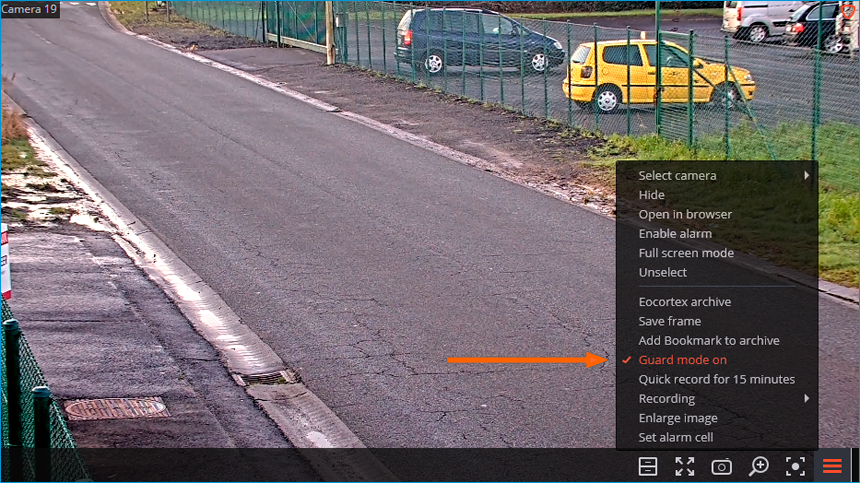
Expand the Additional item on the control panel and select the Guard mode subitem.

In the window that opens, check the cameras that should be set on guard, then click Apply. The same way uncheck the cameras, for which the guard should be set off.
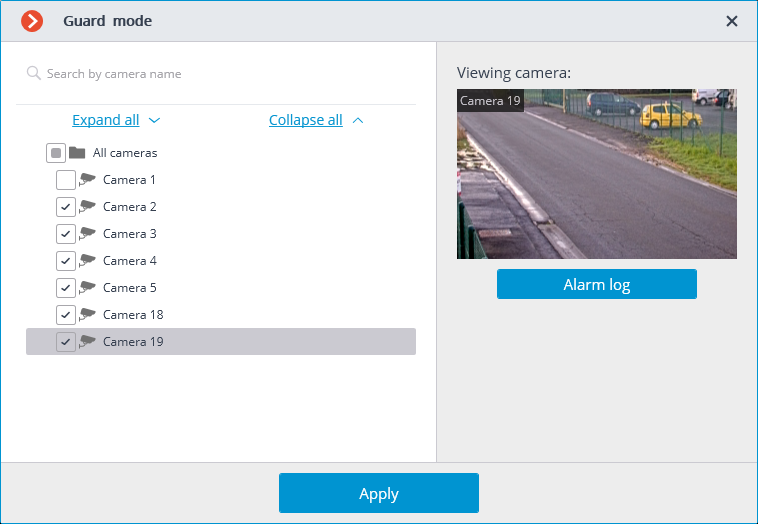
Clicking the Alarm log button opens Events log filtered by alarms.
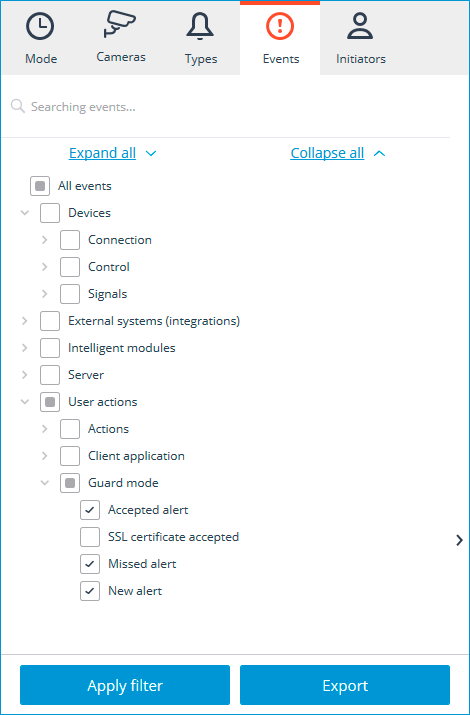
Set up Scheduled Guard mode in the workplace settings.
Alarm generation
Eocortex will generate alarm in case if tasks with the Alarm generation action are configured on the Automation page of the Eocortex Configurator application by the surveillance system administrator.
Note
User alarm is a special event that user can manually generate by clicking a specific button in the interface or selecting the corresponding item in the context menu of the cell. The administrator of the surveillance system can set up any type of action to be executed when the User alarm event is generated, and for each camera a different action can be configured.
To generate User alarm for multiple cameras at once, click the button right to the clock on the control panel.
To generate User alarm for a single camera, call the context menu of the camera cell and select the Enable alarm item.
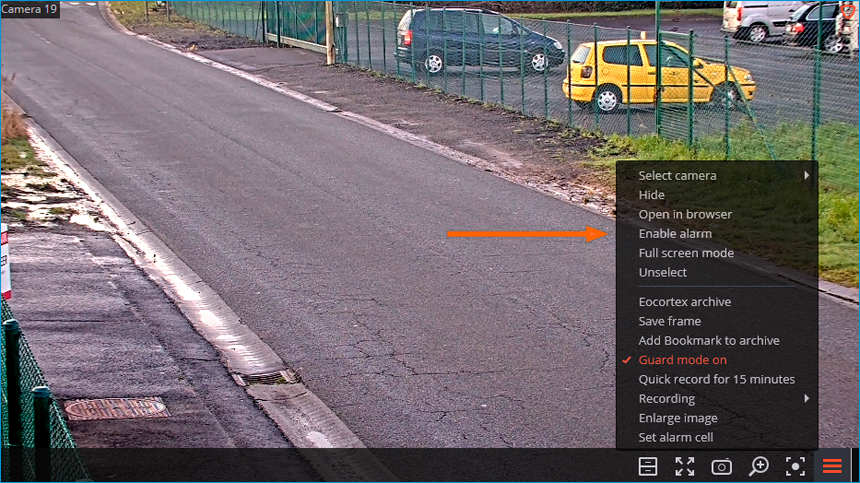
Availability of the button and Enable alarm context menu item can be configured on the Interface tab of the Workplace settings window in the Eocortex Client application.
The list of cameras, for which User alarm will be generated, can be configured on the User alarm channels tab of the Workplace settings window in Eocortex Client.
Alarm notifications
Audio files for notifications are stored in the Sound folder in root directory of the Eocortex Client application (By default: C:\Users\[User name]\AppData\Local\Programs\Eocortex Client\Sounds).
Playback of the sound signal in case of alarm is carried out according to the following rules:
The file will be played regardless of whether the camera is displayed on the regular monitor, the alarm monitor or in the alarm cell.
Only audio files converted to WAV are supported.
Only one file can be used for all alarms.
Each new alarm initiates playback of the selected audio file from the beginning.
Note
It is recommended to avoid using long duration files and frequent generation of alarms of the same type when setting up tasks. Otherwise, the sound file will be interrupted with a new playback every time an alarm is generated.
Playback of the audio signal can be configured on the Sheduled Guard mode tab of the Workplace settings window in Eocortex Client.
Alarm cell is a cell on a regular video surveillance monitor, dynamically displaying cameras where the Alarm occurred.
To assign a cell as alarm cell, call the context menu and select the Set alarm cell item.
If the camera appears in the alarm cell, the alarm must be acknowledged within 1 minute, otherwise it will be marked as missed.
The alarm can be acknowledged by clicking the alarm indicator in the upper right corner of the cell or by selecting the cell.
Placement of the camera in the alarm cell in case of alarm is carried out according to the following rules:
Alarm cell replaces the regular cell, so the maximum number of alarm cells per monitor is limited only by the maximum size of the view — 262 cells.
In case of alarm generation, the camera occupies the first suitable alarm cell in the order.
Note
The order in which alarm cells are filled follows the order of cells on the screen from left to right and from top to bottom. So, for example, in a 5×5 view filled with alarm cells, the top left corner will be cell 1, the top right — cell 5, the bottom right — cell 25.
When the alarm state is acknowledged, the camera continues to be displayed in the alarm cell until it will be replaced by another camera in the alarm state.
Note
Even though the alarm cell remains visually occupied by the camera with acknowledged alarm, it still will be considered free for the alarmed cameras allocation algorithm. Thus, if a de-alarmed camera is placed in alarm cell 1, it will be replaced by another camera when an alarm event occurs, regardless of whether there are other free alarm cells on the monitor or not.
A camera without an alarm state can be manually assigned to the alarm cell, but it will be automatically replaced with a camera in alarm state if the need arises.
If a camera is already assigned to a regular cell on a monitor, it will not be moved to or additionally opened in an alarm cell on the same monitor. The
alarm indicator will be displayed for this camera in the regular cell.
If alarm and regular cells are on different monitors of the same workstation, the camera opened in the regular cell on one monitor will also be opened in the alarm cell on the other monitor. The
alarm indicator will be displayed in both cells.
If all alarm cells are occupied by cameras with active (not acknowledged) alarm state, the new camera will not be displayed.
If the same workplace has both alarm cells and alarm monitor, a camera in Alarm state will be displayed on both of them.
If the Display only on the alarm monitor option is enabled on the Sheduled Guard mode tab of the Workplace settings window, alarmed cameras will not be assigned to alarm cells.
Camera can be manually removed from the alarm cell by selecting the Hide item of the cell context menu.
Availability of the Set alarm cell context item and the possibility of alarm cells usage can be configured on the Interface tab of the Workplace settings window in Eocortex Client.
Alarm monitor is a dedicated monitor dynamically displaying cameras where the Alarm occurred.
If the camera appears on the alarm monitor, the alarm must be acknowledged within 1 minute, otherwise it will be marked as missed.
The alarm can be acknowledged by clicking the alarm indicator in the upper right corner of the cell or by double-clicking to the cell.
Placement of the camera on the alarm monitor in case of alarm is carried out according to the following rules:
The maximum number of alarm monitors per workplace — not more than one.
The maximum number of cells on the alarm monitor — no more than 256.
The alarm monitor selects the optimal screen grid automatically, depending on the number of cameras in the Alarm state that need to be displayed. The optimal grid is the one that allows to display all cameras in Alarm state with the minimum number of empty cells.
Note
The alarm monitor supports the following screen grids based on the number of camera cells: 1; 4; 9; 16; 25; 30; 36; 49; 64; 81; 100; 110; 150; 182; 256.
Note
For example: The alarm monitor currently displays four cameras in the Alarm state, the optimal grid is 4 cells. When new cameras in the Alarm state appear, the grid will automatically change to the first one that can fit all the cameras.
Cameras cannot be manually placed on the alarm monitor.
If an alarm is acknowledged by clicking the
alarm indicator, the camera will be kept in its current cell on the alarm monitor until it will be replaced.
If an alarm is acknowledged by double-clicking to the cell, the camera will be removed from the alarm monitor.
If all alarm monitor cells are occupied by cameras, the new camera in the Alarm state will be placed to the first unpinned cell with an acknowledged alarm.
If all alarm monitor cells are occupied by pinned cameras or cameras with an active (not acknowledged) Alarm state, the new camera in Alarm state will not be displayed on the screen.
If the same workplace has both alarm cells and alarm monitor, a camera in Alarm state will be displayed on both of them.
If the Display only on the alarm monitor option is enabled on the Sheduled Guard mode tab of the Workplace settings window, alarmed cameras will be displayed only on the alarm monitor.
Usage of a monitor as the alarm monitor can be configured on the Monitors tab of the Workplace settings window in Eocortex Client.
Cameras can be removed from the alarm monitor not only manually, but also in automatically.
If the Set the limit of an alarm display period on the alarm monitor option is configured in the workplace settings, the cameras will automatically hide from the alarm monitor after the expiration of the set time from the moment of alarm generation.
At the same time, if any camera needs to be kept on the alarm monitor, it can be pinned to the cell.
To pin the camera to the alarm monitor cell, use the button located in the upper right corner of the cell.
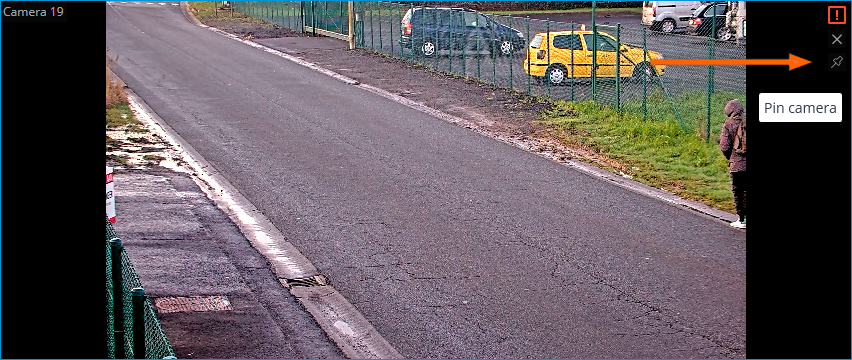
Pinning of cameras to the alarm monitor cells is carried out according to the following rules:
The maximum number of assigned cells is limited by the maximum number of alarm monitor cells — 256.
A camera that appears in the alarm monitor cell will not be automatically pinned to this cell.
A camera pinned to the alarm monitor cell will not be hidden by timeout as unpinned one.
If a camera is pinned to the alarm monitor cell, it will remain in that cell if an alarm is generated again.
When reducing the size of the screen grid, the pinned camera may change position on the screen if the cells to the left and/or above do not contain other pinned or alarmed cameras.
All camera pins are reset when switching a camera on the alarm monitor to full screen, going to the video wall, manually hiding the camera from the cell or restarting the Eocortex Client application.
The automatic removal of cameras from the alarm monitor and the possibility to pin cameras associated with it can be configured on the Sheduled Guard mode tab of the Workplace settings window in Eocortex Client.
Note
This capability is not present in some types of licenses.
For cameras placed on the site plans, it is possible to configure displaying of the Alarm indication in the Plans section.
When an alarm is generated, the cameras placed on the plans will be colored red.
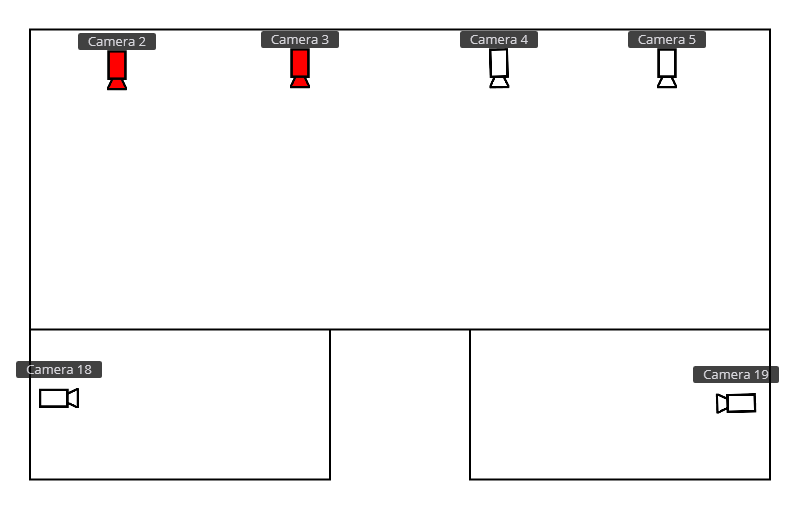
The indication can be removed in one of the following ways:
By positioning the mouse cursor over the camera icon and waiting for the preview window to appear.
By clicking the camera icon on the plan.
By acknowledging the alarm on the regular or alarm monitor.
Warning
Removal of alarm indication on plans does not cause the alarm acknowledgment.
Display of the alarm indication on plans can be configured on the Sheduled Guard mode tab of the Workplace settings window in Eocortex Client.